miR-129-5p inhibits prostate cancer proliferation via targeting ETV1
- PMID: 31190859
- PMCID: PMC6512784
- DOI: 10.2147/OTT.S183435
miR-129-5p inhibits prostate cancer proliferation via targeting ETV1
Abstract
Background: Prostate cancer is one of the most commonly diagnosed diseases in males.
Methods: RT-qPCR was used to detect miR-129-5p expression in tumor tissues and adjacent normal tissues from patients with prostate cancer. The cell proliferation assay and colony forming assay were used to study the role of miR-129-5p in mediating prostate cancer cell growth. Bioinformatic analysis and dual luciferase assay were performed to predict and confirm ETV1 as a target gene of miR-129-5p.
Results: We found that miR-129-5p levels were decreased significantly in human prostate cancer tissues compared with matched normal tissues from patients with prostate cancer. Overexpression of miR-129-5p suppressed prostate cancer cell growth while antagonist of miR-129-5p promoted cell proliferation in immortal prostate cell line RWPE-1. In addition, elevation of miR-129-5p decreased ETV1 expression in prostate cancer cells while downregulation of miR-129-5p increased ETV1 expression in RWPE-1. Mechanistically, ETV1 is confirmed a direct target of miR-129-5p in prostate cancer cells. Through repression of ETV1 expression, miR-129-5p could inactivate YAP signaling in prostate cancer cells. In addition, overexpression of ETV1 attenuated miR-129-5p induced cell proliferation in prostate cancer cells. Correlation analysis further revealed that there was a negative correlation between miR-129-5p levels and ETV1 mRNA levels in tumor tissues from patients with prostate cancer.
Conclusion: Our results identified miR-129-5p as a tumor suppressor in prostate cancer via repression of ETV1.
Keywords: ETV1; microRNA; proliferation; prostate cancer.
Conflict of interest statement
Disclosure The authors report no conflicts of interest in this work.
Figures

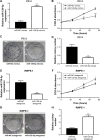
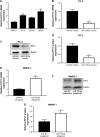

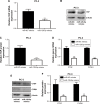
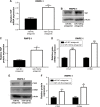
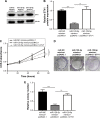
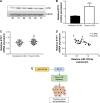
Similar articles
-
miR-17-5p suppresses cell proliferation and invasion by targeting ETV1 in triple-negative breast cancer.BMC Cancer. 2017 Nov 10;17(1):745. doi: 10.1186/s12885-017-3674-x. BMC Cancer. 2017. PMID: 29126392 Free PMC article.
-
MiR-15b-5b Regulates the Proliferation of Prostate Cancer PC-3 Cells via Targeting LATS2.Cancer Manag Res. 2020 Oct 28;12:10669-10678. doi: 10.2147/CMAR.S266421. eCollection 2020. Cancer Manag Res. 2020. PMID: 33149674 Free PMC article.
-
MicroRNA-493-5p promotes apoptosis and suppresses proliferation and invasion in liver cancer cells by targeting VAMP2.Int J Mol Med. 2018 Mar;41(3):1740-1748. doi: 10.3892/ijmm.2018.3358. Epub 2018 Jan 2. Int J Mol Med. 2018. PMID: 29328362
-
Inhibition of miR-9-5p suppresses prostate cancer progress by targeting StarD13.Cell Mol Biol Lett. 2019 Mar 8;24:20. doi: 10.1186/s11658-019-0145-1. eCollection 2019. Cell Mol Biol Lett. 2019. PMID: 30899277 Free PMC article.
-
MiR-129-5p inhibits proliferation of gastric cancer cells through targeted inhibition on HMGB1 expression.Eur Rev Med Pharmacol Sci. 2020 Apr;24(7):3665-3673. doi: 10.26355/eurrev_202004_20829. Eur Rev Med Pharmacol Sci. 2020. PMID: 32329842
Cited by
-
Relapse and Survival in Bladder Cancer Patients Undergoing microRNA-129 and microRNA-145 Assays.Asian Pac J Cancer Prev. 2024 Jun 1;25(6):2113-2121. doi: 10.31557/APJCP.2024.25.6.2113. Asian Pac J Cancer Prev. 2024. PMID: 38918674 Free PMC article.
-
ETV1 genetic polymorphisms as a candidate prognosis biomarker of Gastrointestinal stromal tumor.Cancer Chemother Pharmacol. 2025 Jul 2;95(1):68. doi: 10.1007/s00280-025-04789-2. Cancer Chemother Pharmacol. 2025. PMID: 40601091
-
Pancreatic Cancer Progression Is Regulated by IPO7/p53/LncRNA MALAT1/MiR-129-5p Positive Feedback Loop.Front Cell Dev Biol. 2021 Oct 1;9:630262. doi: 10.3389/fcell.2021.630262. eCollection 2021. Front Cell Dev Biol. 2021. PMID: 34660566 Free PMC article.
-
Prognostic Value of miR-1826 in Prostate Cancer and Its Regulatory Effect on Tumor Progression.Onco Targets Ther. 2021 Aug 13;14:4467-4475. doi: 10.2147/OTT.S295125. eCollection 2021. Onco Targets Ther. 2021. PMID: 34413652 Free PMC article.
-
miR-129-5p inhibits clear cell renal cell carcinoma cell proliferation, migration and invasion by targeting SPN.Cancer Cell Int. 2021 May 17;21(1):263. doi: 10.1186/s12935-021-01820-3. Cancer Cell Int. 2021. PMID: 34001147 Free PMC article.
References
-
- Litwin MS, Tan HJ. The diagnosis and treatment of prostate cancer. JAMA. 2017;317(24):2532–2542. - PubMed
-
- Jemal A, Bray F, Center MM, Ferlay J, Ward E, Forman D. Global cancer statistics. CA Cancer J Clin. 2011;61(2):69–90. - PubMed
-
- Antenor JA, Roehl KA, Eggener SE, Kundu SD, Han M, Catalona WJ. Preoperative PSA and progression-free survival after radical prostatectomy for stage T1c disease. Urology. 2005;66(1):156–160. - PubMed
LinkOut - more resources
Full Text Sources

